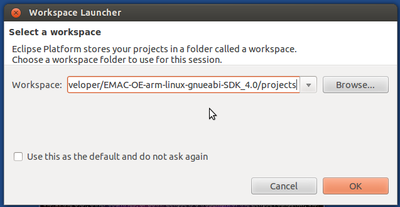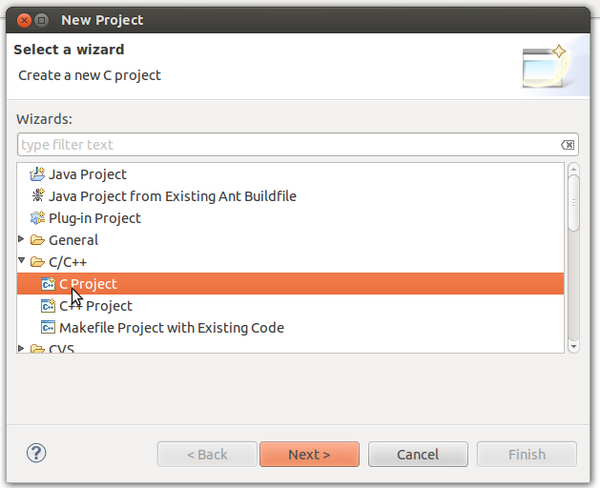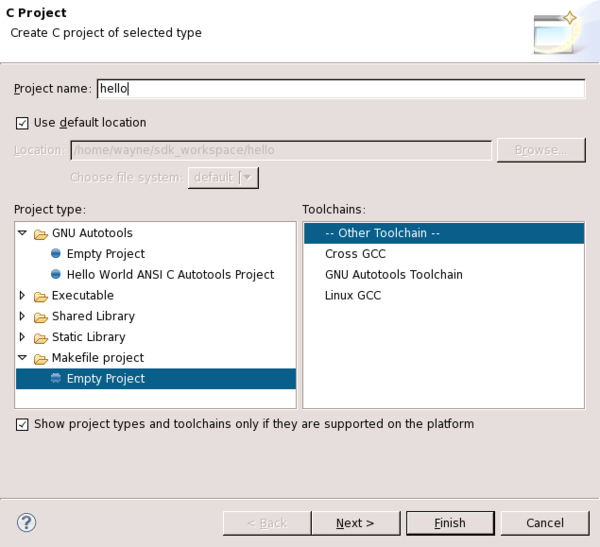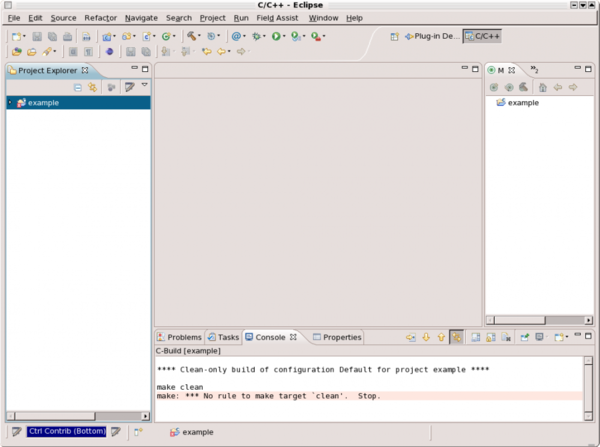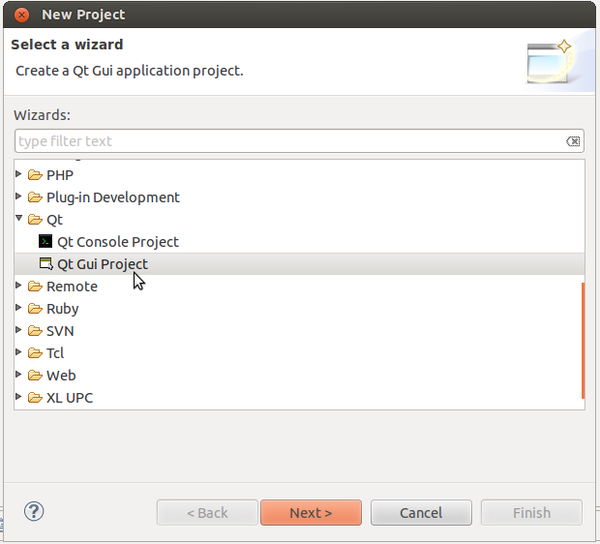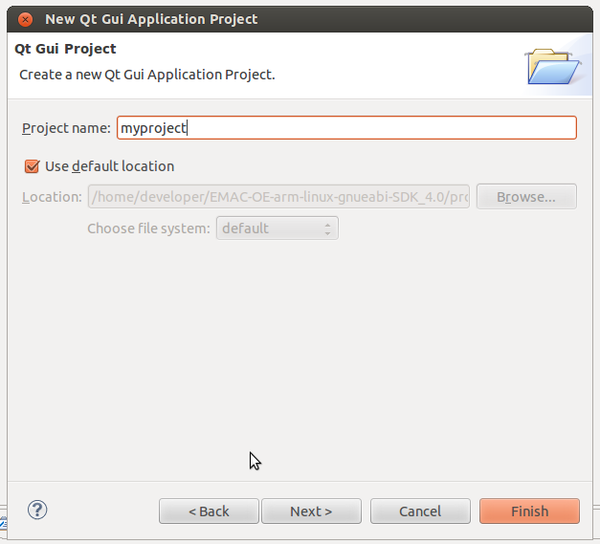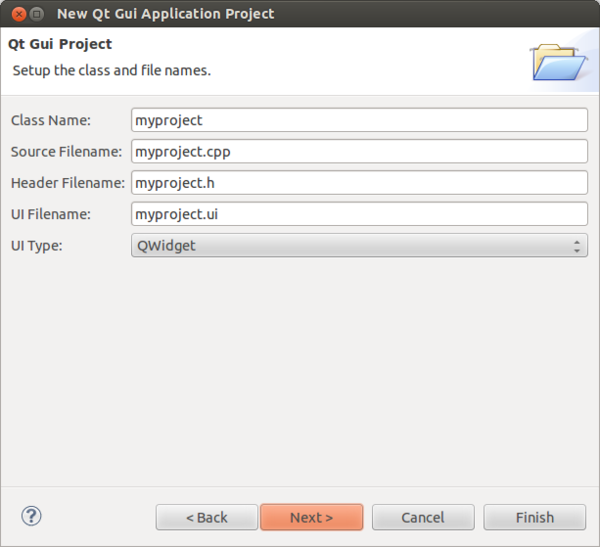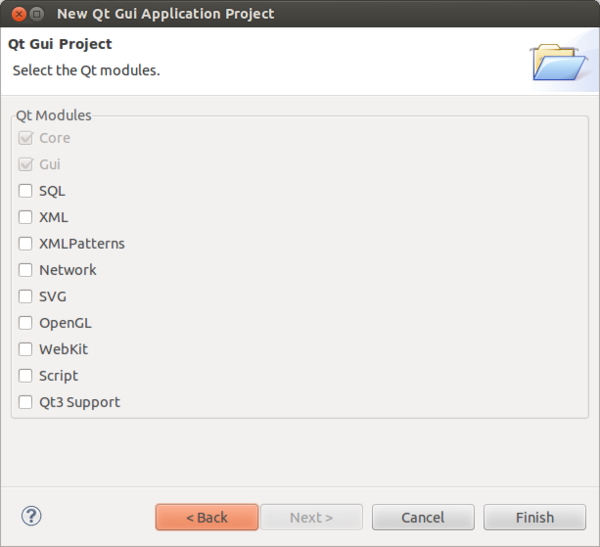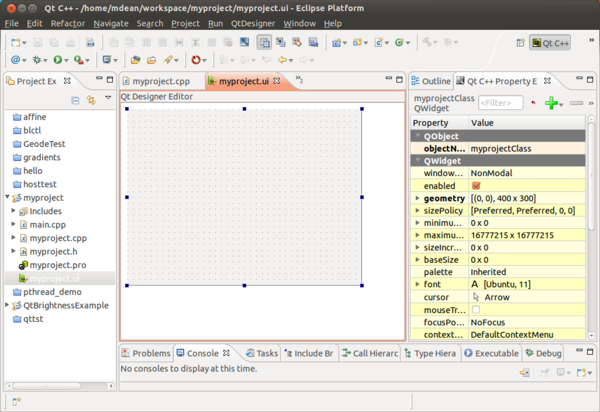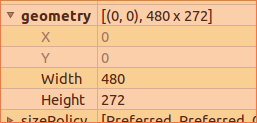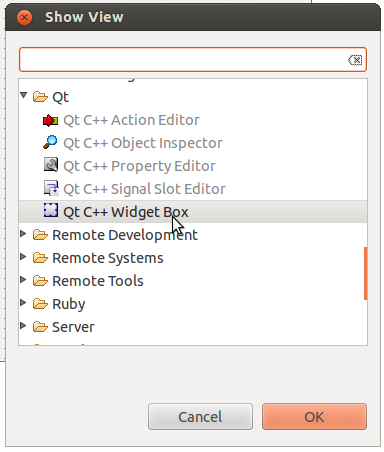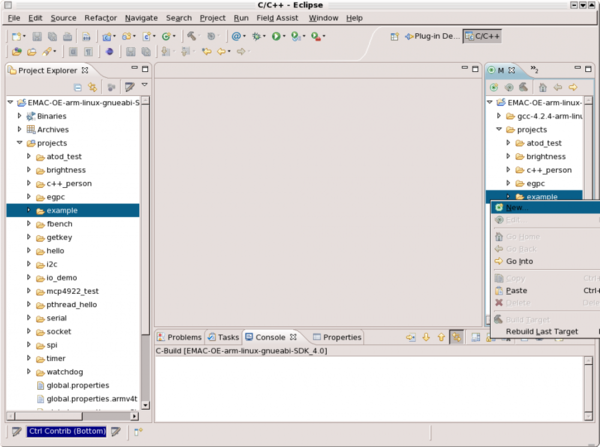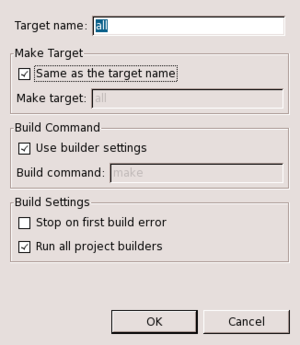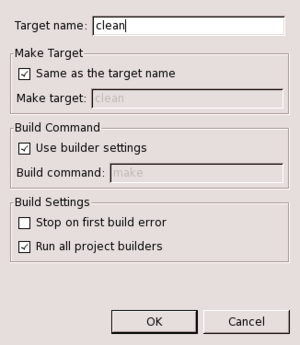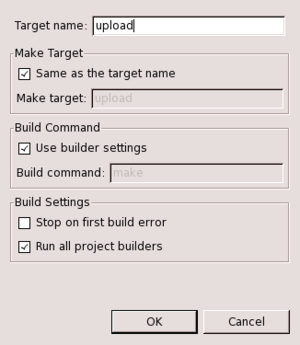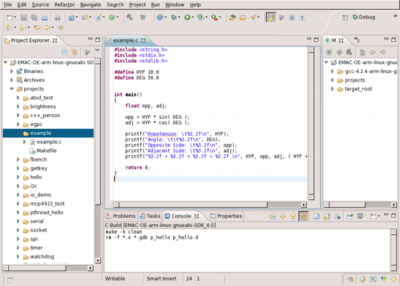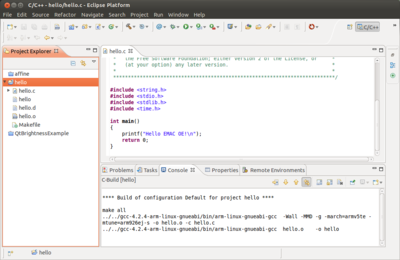Difference between revisions of "Creating New Projects with Eclipse"
| Line 47: | Line 47: | ||
* The workbench should look similar to Figure 4 below. | * The workbench should look similar to Figure 4 below. | ||
| − | [[File:Eclipse_workbench.png|600px|thumb|left|Figure | + | [[File:Eclipse_workbench.png|600px|thumb|left|Figure 4: New Eclipse Project ]] |
<br clear=all> | <br clear=all> | ||
| Line 63: | Line 63: | ||
* Under Qt, select Qt Gui Project or Qt Console Project then click Next | * Under Qt, select Qt Gui Project or Qt Console Project then click Next | ||
| − | [[File:New_qt_project.png|600px|thumb|left|Figure | + | [[File:New_qt_project.png|600px|thumb|left|Figure 5: New Qt Project ]] |
<br clear=all> | <br clear=all> | ||
| Line 71: | Line 71: | ||
{{mbox | type=information | text = Make sure that the Location is set to the /path/to/sdk/projects folder as noted above.}} | {{mbox | type=information | text = Make sure that the Location is set to the /path/to/sdk/projects folder as noted above.}} | ||
| − | [[File:New_qt_gui_project.png|600px|thumb|left|Figure | + | [[File:New_qt_gui_project.png|600px|thumb|left|Figure 6: New Qt Project ]] |
<br clear=all> | <br clear=all> | ||
| Line 77: | Line 77: | ||
* Accept the default file names for the project and click Next | * Accept the default file names for the project and click Next | ||
| − | [[File:New_qt_project_pg2.png|600px|thumb|left|Figure | + | [[File:New_qt_project_pg2.png|600px|thumb|left|Figure 7: New Qt Project ]] |
<br clear=all> | <br clear=all> | ||
| Line 83: | Line 83: | ||
* Select any additional Qt modules that are required for the project, then click Finish | * Select any additional Qt modules that are required for the project, then click Finish | ||
| − | [[File:New_qt_gui_project_pg3.png|600px|thumb|left|Figure | + | [[File:New_qt_gui_project_pg3.png|600px|thumb|left|Figure 8: New Qt Project ]] |
<br clear=all> | <br clear=all> | ||
| Line 89: | Line 89: | ||
</cl> | </cl> | ||
| − | The project is now set up and ready to begin coding an application. For more information on creating Qt applications see [ http://qt-project.org/doc/qt-4.8/gettingstartedqt.html Getting Started Programming with Qt ] on the Qt website. | + | The project is now set up and ready to begin coding an application. For more information on creating Qt applications see [http://qt-project.org/doc/qt-4.8/gettingstartedqt.html Getting Started Programming with Qt] on the Qt website. |
| − | == | + | ==QT GUI Project== |
| + | |||
| + | The Eclipse IDE contains a graphical editor for creating GUI applications. The following will show the steps for using the Qt Designer Editor. | ||
| + | |||
| + | <cl> | ||
| + | 1. Open a Qt Gui project or create one as above. | ||
| + | * Double click on the myproject.ui file in the Project Explorer pane. This will open the Qt Designer Editor window. See figure 9. | ||
| + | |||
| + | [[File:Eclipse_qt_designer_new_ui.png|600px|thumb|left|Figure 9: Eclipse Qt Designer Editor window ]] | ||
| + | |||
| + | <br clear=all> | ||
| + | |||
| + | * The properties for the project can be modified in the right hand pane Qt C++ Property Editor tab. | ||
| + | ** The geometry of the project window can be set here or by dragging the handles in the editor window. | ||
| + | ** 480x272 is the correct resolution for EMAC's 4.3" display | ||
| + | |||
| + | [[File:Eclipse_qt_designer_geometry.png|600px|thumb|left|Figure 10: Qt Designer Geometry Properties ]] | ||
| + | |||
| + | <br clear=all> | ||
| + | |||
| + | The QT C++ Widget Box allows the user to drag and drop components (buttons, textboxes, labels...) onto the editor. | ||
| + | * To show the editor: | ||
| + | ** On the Eclipse menubar click Window->Show View->Other... | ||
| + | |||
| + | [[File:Eclipse_qt_widget_box.png|600px|thumb|left|Figure 11: Qt Designer Geometry Properties ]] | ||
| + | |||
| + | <br clear=all> | ||
| + | |||
| + | </cl> | ||
| + | |||
| + | ==Make file Setup== | ||
===Generate Eclipse Make Targets=== | ===Generate Eclipse Make Targets=== | ||
| Line 104: | Line 134: | ||
* Select ''New...'' | * Select ''New...'' | ||
| − | [[File:new_make_target3.png|600px|thumb|left|Figure | + | [[File:new_make_target3.png|600px|thumb|left|Figure 12: Make Target context menu ]] |
<br clear=all> | <br clear=all> | ||
| − | * Create the make targets ''all, clean'' and ''upload'' as in figures | + | * Create the make targets ''all, clean'' and ''upload'' as in figures 13,14 and 15. |
<gallery widths=300px heights=400px mode="traditional"> | <gallery widths=300px heights=400px mode="traditional"> | ||
| − | File:Make_new_all.png|Figure | + | File:Make_new_all.png|Figure 13: Make New All Target |
| − | File:Make_new_clean.png|Figure | + | File:Make_new_clean.png|Figure 14: Make New Clean Target |
| − | File:Make_new_upload.png|Figure | + | File:Make_new_upload.png|Figure 15: Make New Upload Target |
</gallery> | </gallery> | ||
</cl> | </cl> | ||
| Line 118: | Line 148: | ||
===Modify the Makefile=== | ===Modify the Makefile=== | ||
| − | Once the Make Targets have been created, a Makefile needs to be created that contains the | + | Once the Make Targets have been created, a Makefile needs to be created that contains the samalt texte targets so that GNU make knows how to compile and link the source into a binary that will run on the target machine. See the [[Creating_a_New_EMAC_OE_SDK_Project#Modify_the_Makefile | Makefile modification section]] of the EMAC OE SKE New Project guide for more explanation. |
==Alternate Project Locations== | ==Alternate Project Locations== | ||
| Line 154: | Line 184: | ||
* If the new C file did not open automatically, open it by double clicking hello.c the the left pane | * If the new C file did not open automatically, open it by double clicking hello.c the the left pane | ||
* Copy the code from Listing 1. in the [[Creating_a_New_EMAC_OE_SDK_Project#Write_the_C_Code | C code writing ]] section of the EMAC OE SKE New Project guide. | * Copy the code from Listing 1. in the [[Creating_a_New_EMAC_OE_SDK_Project#Write_the_C_Code | C code writing ]] section of the EMAC OE SKE New Project guide. | ||
| − | * Save the file by selecting ''File->Save'' from the Eclipse menubar. See figure | + | * Save the file by selecting ''File->Save'' from the Eclipse menubar. See figure 16 for how Eclipse should look. |
| − | [[File:Eclipse_hello_new.png|400px|thumb|left|Figure | + | [[File:Eclipse_hello_new.png|400px|thumb|left|Figure 16: Eclipse Workspace]] |
<br clear=all> | <br clear=all> | ||
| Line 162: | Line 192: | ||
===Cross-Compile=== | ===Cross-Compile=== | ||
| − | To build the project, ensure the project is highlighted in the Project Explorer treeview in the left pane, then select Project->Build Project. For a Qt project first run Project->Run qmake. The project will now build, and your window should appear similar to figure | + | To build the project, ensure the project is highlighted in the Project Explorer treeview in the left pane, then select Project->Build Project. For a Qt project first run Project->Run qmake. The project will now build, and your window should appear similar to figure 17. |
| − | :[[File:Eclipse hello project built.png|400px|thumb|left|Figure | + | :[[File:Eclipse hello project built.png|400px|thumb|left|Figure 17: Eclipse Workspace]] |
<br clear=all> | <br clear=all> | ||
| Line 171: | Line 201: | ||
| − | + | Old pages: | |
| + | http://wiki.emacinc.com/doku.php?id=linux:eclipse:newsdkproject | ||
| + | http://wiki.emacinc.com/doku.php?id=linux:eclipse:example | ||
==See Also== | ==See Also== | ||
| + | [http://www.eclipse.org/documentation/ Eclipse Documentation] | ||
| + | [http://qt-project.org/doc/ QT Documentation] | ||
| + | |||
[[ Using_the_EMAC_OE_SDK_Projects_with_Eclipse#EMAC_SDK_Example:_Compile_and_Run_the_hello_Project | Compile and Run ]] procedure from the Eclipse Example Project Guide to compile the project. Note: There may be differences between | [[ Using_the_EMAC_OE_SDK_Projects_with_Eclipse#EMAC_SDK_Example:_Compile_and_Run_the_hello_Project | Compile and Run ]] procedure from the Eclipse Example Project Guide to compile the project. Note: There may be differences between | ||
[[Category:EMAC Eclipse]] | [[Category:EMAC Eclipse]] | ||
Revision as of 15:30, 8 November 2013
The purpose of this guide is to demonstrate how to create a new project in Eclipse using the EMAC Open Embedded SDK. This will include a step-by-step procedure which assumes that the SDK has already been imported .
Since this guide is specific to the EMAC OE SDK, it is not interchangeable with a general guide on creating a new Eclipse project.
Contents
Required Tools
- GNU Make
- EMAC Eclipse 3.6
- EMAC OE SDK
New Project Setup
Before getting started creating a new project, the following setup must be performed. It is up to the application developer whether the new project will be placed in the EMAC-OE-arm-linux-gnueabi-SDK_XX.YY/projects project folder in the Eclipse Project Explorer View or within its own project folder. The latter does involve more complexity during setup, though it is a bit neater to work with since it does not require the developer to navigate the SDK directory tree to get to the new project. Note that only one of the following subsections is necessary to move on to the General Setup Section.
Creating a New SDK C Project
-
Make sure that the SDK has been configured according to Configuring the SDK
-
Start Eclipse.

When Eclipse starts, the user will be prompted to choose a workspace location. The recommended location is /path/to/sdk/projects. This will allow the user to easily leverage the use of the SDK. If a different location is chosen, see the section below on alternate project locations.
-
From the Eclipse menubar, select File->New->Project
-
Under C/C++, select C Project then next
-
Enter “hello” in the Project name: field.
-
Scroll down and choose Makefile Project -> Empty Project in the Project type: list.
-
Ensure that – Other Toolchain – is selected in the Toolchains: list.
-
Click the Finish button.
-
Select Yes to open the C/C++ perspective if prompted
-
The workbench should look similar to Figure 4 below.
Creating a New SDK QT Project
The process for creating a new QT project is similar to creating a new C project with some minor differences.
-
Make sure that the SDK has been configured according to Configuring the SDK
-
Start Eclipse.
-
From the Eclipse menubar, select File->New->Project
-
Under Qt, select Qt Gui Project or Qt Console Project then click Next
-
Enter myproject in the Project Name: field and click Finish.

Make sure that the Location is set to the /path/to/sdk/projects folder as noted above.
-
Accept the default file names for the project and click Next
-
Select any additional Qt modules that are required for the project, then click Finish
The project is now set up and ready to begin coding an application. For more information on creating Qt applications see Getting Started Programming with Qt on the Qt website.
QT GUI Project
The Eclipse IDE contains a graphical editor for creating GUI applications. The following will show the steps for using the Qt Designer Editor.
-
Open a Qt Gui project or create one as above.
-
Double click on the myproject.ui file in the Project Explorer pane. This will open the Qt Designer Editor window. See figure 9.
-
The properties for the project can be modified in the right hand pane Qt C++ Property Editor tab.
- The geometry of the project window can be set here or by dragging the handles in the editor window.
- 480x272 is the correct resolution for EMAC's 4.3" display
The QT C++ Widget Box allows the user to drag and drop components (buttons, textboxes, labels...) onto the editor.
-
To show the editor:
- On the Eclipse menubar click Window->Show View->Other...
Make file Setup
Generate Eclipse Make Targets
The following will demonstrate how to add the all, clean and upload targets for make
-
Click on the Make Target view tab in the right hand pane.

If the Make Target tab is not visible, select Window -> Show View -> other... from the Eclipse toolbar. Then select Make -> Make Target. -
Right click on hello to bring up the context menu.
-
Select New...
-
Create the make targets all, clean and upload as in figures 13,14 and 15.
Modify the Makefile
Once the Make Targets have been created, a Makefile needs to be created that contains the samalt texte targets so that GNU make knows how to compile and link the source into a binary that will run on the target machine. See the Makefile modification section of the EMAC OE SKE New Project guide for more explanation.
Alternate Project Locations
If the project is created outside of the /path/to/sdk/projects directory, the paths present in the make file and path to the SDK and global.properties files will need to be modified as below.
-
Copy the correct global.properties file from the SDK/projects directory to the current project directory
cp -L /path/to/sdk/projects/global.properties /path/to/project/hello
-
Modify the include line at the top of the make file to refer to the new global.properties file
include global.properties -
Change the value of
SDKBASEin global.properties to point to the location of the SDK installation.
Using the New Project
The next step is to write some example C code for the project. See Write the C Code section of the EMAC OE SKE New Project guide for more explanation.
-
Open the C/C++ Perspective if it is not open already.
-
From the Eclipse menubar, select Window -> Open Perspective -> Other...
-
Select C/C++ and click OK
-
-
Create a new C file using the Eclipse New Source Wizard.
-
From the Eclipse menubar, select File-> New-> Source File.
-
Set the Source File: field to hello.c
-
Set the value of Template: to <None>
-
Click Finish
-
-
If the new C file did not open automatically, open it by double clicking hello.c the the left pane
-
Copy the code from Listing 1. in the C code writing section of the EMAC OE SKE New Project guide.
-
Save the file by selecting File->Save from the Eclipse menubar. See figure 16 for how Eclipse should look.
Cross-Compile
To build the project, ensure the project is highlighted in the Project Explorer treeview in the left pane, then select Project->Build Project. For a Qt project first run Project->Run qmake. The project will now build, and your window should appear similar to figure 17.
If there are any build errors, they will be shown in the Console and/or Problems tabs on the bottom.
Old pages:
http://wiki.emacinc.com/doku.php?id=linux:eclipse:newsdkproject http://wiki.emacinc.com/doku.php?id=linux:eclipse:example
See Also
Eclipse Documentation QT Documentation
Compile and Run procedure from the Eclipse Example Project Guide to compile the project. Note: There may be differences between
